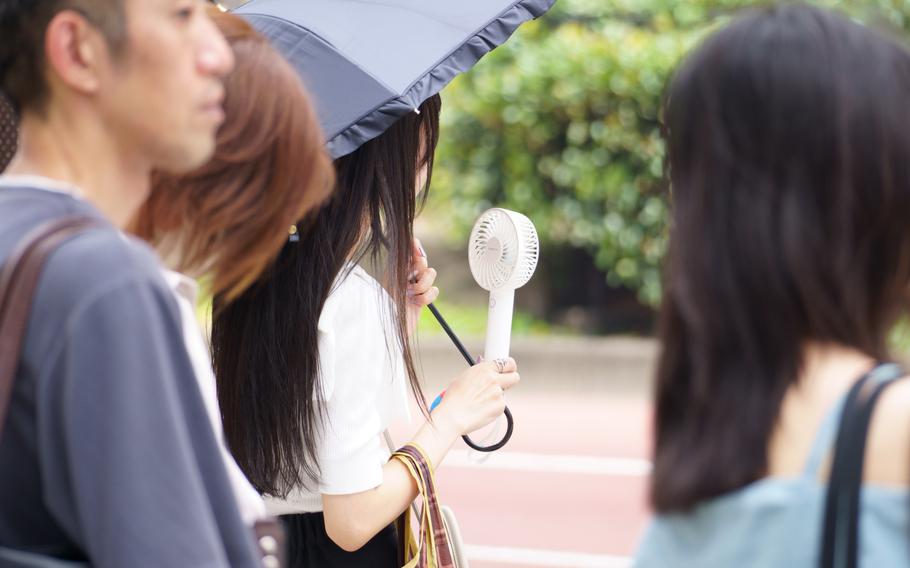Asia-Pacific
Heatstroke victims on the rise as black flags fly over US bases in Japan
Stars and Stripes July 31, 2024

A woman uses a portable electric fan and a parasol to combat heat in Tokyo's Shinjuku ward, Wednesday, July 31, 2024. (Akifumi Ishikawa/Stars and Stripes)
YOKOTA AIR BASE, Japan — The Land of the Rising Sun’s infamous summer heat claimed 22 lives and pushed past 10,000 heatstroke cases in a single week for the first time, according to Japanese media reports.
Hospitals around the country treated 12,666 heatstroke patients through the seven days that ended Sunday, of whom 4,442 were hospitalized, according to public broadcaster NHK on Wednesday.
Heatstroke alerts were issued Monday for 38 of the nation’s 47 prefectures, according to the Japan Meteorological Agency and the Environment Ministry. Temperatures reached 104 degrees Fahrenheit in some cities for the first time this year.

Women use a portable electric fan to combat heat in Tokyo's Shinjuku ward, Wednesday, July 31, 2024. (Akifumi Ishikawa/Stars and Stripes)
At U.S. military bases across Japan, “black flag” days are again routine, indicating high temperatures unsafe for outdoor training or exercise.
Black flag conditions start at 90 degrees and above; red flag is 88 to 89.9 degrees; yellow is 85 to 87.9; and green is 80 to 84.9.
Yokosuka Naval Base, homeport for the U.S. 7th Fleet, and Marine Corps bases on Okinawa were in black flag conditions Wednesday.
Yokota, the headquarters for U.S. Forces Japan, has signaled 14 black flag days so far this year; the annual average is 23, base spokesman Master Sgt. Nathaniel Allen said by email Wednesday.
During black flag conditions, physical training and strenuous exercise is suspended for all personnel outside of operational commitments.
Heat exhaustion, the initial condition, is characterized by dizziness, thirst, heavy sweating, nausea, weakness and cramping, Allen said. When this happens, it’s crucial to cease activity, move to a cooler area, remove or loosen clothing, sip cool water and monitor for improvement.
“If one can successfully take these steps and symptoms improve or resolve, then they have prevented progression to heatstroke,” he said.
When the outdoors feels more like a furnace, the Japan Fire and Disaster Management Agency advises people to protect against heatstroke by using air conditioners appropriately and drinking enough water, according to its website.
Of the thousands of heatstroke patients from the previous week, more than half were 65 or older; most suffered heatstroke inside their homes, NHK reported. Cases are expected to peak in August.
July 22 was the hottest day on record, according to a NASA analysis of global daily temperature data. The global average temperature reached 62.87 degrees; the average surface temperature on Earth is approximately 59 degrees.
Most of France was under a heat warning, with temperatures in Paris, which is hosting the 2024 Olympics, hitting 97 degrees, according to Météo-France, the country’s meteorological agency.
In the U.S., Arizona, Oregon, Nevada and California all experienced record-breaking heat in July, according to National Public Radio on July 11.